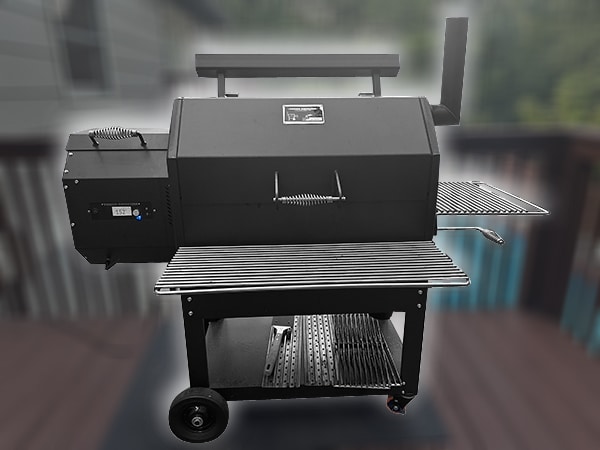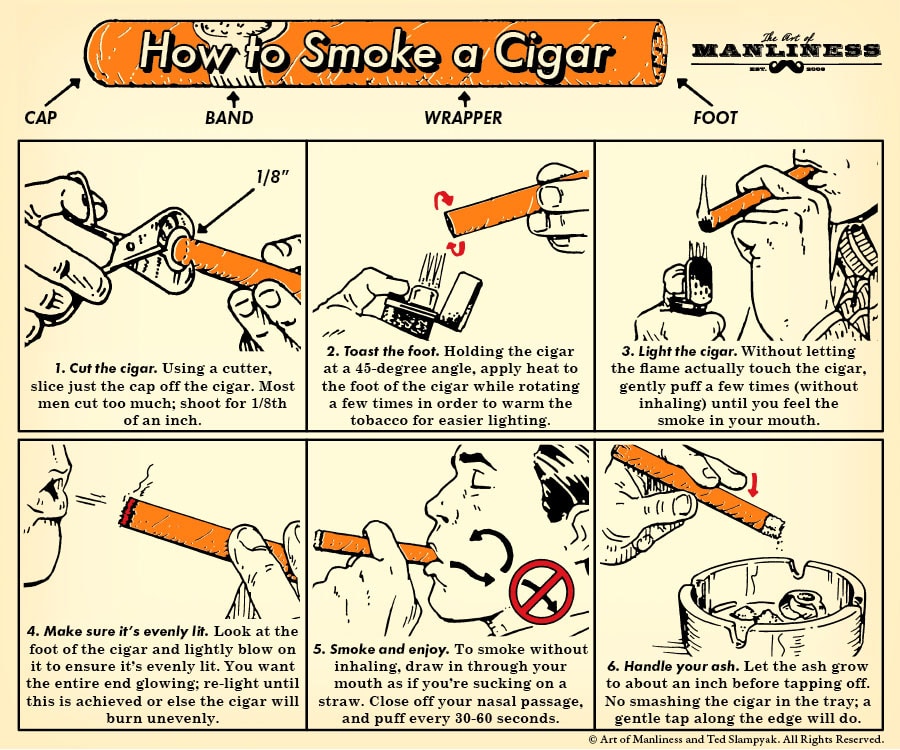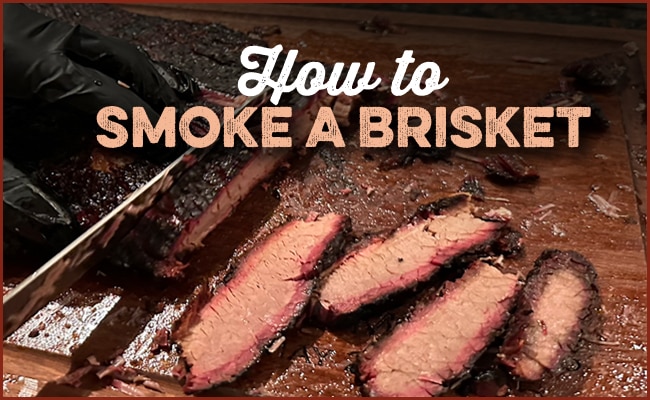
A few weeks ago, I wrote about why I love my new wood pellet smoker/grill. Not only can I grill burgers on it, but it’s allowed me to progress towards being a pitmaster in a short amount of time.
Because the wood pellet grill uses a computer to keep the temperature constant without you having to finagle things, the first time I smoked a brisket, the process was smooth, and it turned out top-notch.
Guiding me through my first time smoking a brisket was my friend and AoM’s resident BBQ consultant, Karl Engel. You might remember Karl from our series of videos about smoking we did over a decade ago on the AoM YouTube channel.
Below, I take you through all the steps I followed to smoke a giant brisket my father-in-law is still raving about.
Follow these steps yourself and you can smoke a first, BBQ-competition-worthy brisket that will provide mounds and mounds of delicious meat for your family and friends at your next dinner party.
Your Smoker
I used my Yoder wood pellet smoker/grill. It makes smoking meat stupid easy. Just set the desired temperature and let the computer take care of the rest. Most wood pellet smokers also come with an app that allows you to track the internal temperature of your meat so you know when your brisket is ready to get wrapped up in foil and then later pulled out. A wood pellet smoker will make smoking your first brisket much easier.
Of course, you can always use a traditional smoker that uses regular old wood. That’s how people have smoked meat for centuries. The downside is that you don’t have the easy temperature control that you get with the wood pellet smoker, and you’ve got to do more tending to the fire. Some people like that aspect of traditional smokers. Makes it feel more craft-like.
You can also use a Big Green Egg or similar backyard cooking appliances.
Because I have a wood pellet smoker, these instructions will be geared towards that. Adjust based on what you’re using to smoke.
The Brisket
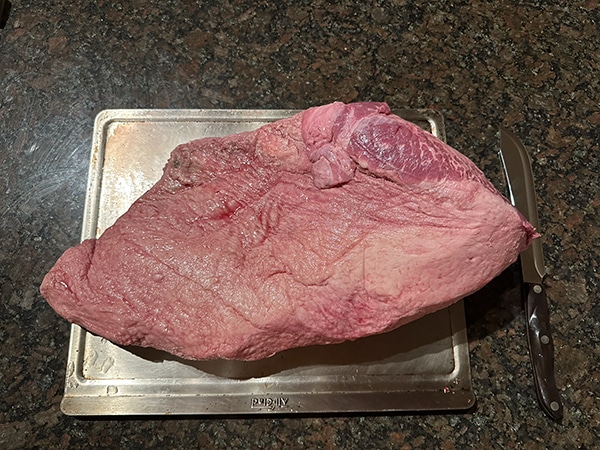
Go to your local butcher (shoutout to Siegi’s here in Tulsa; it’s where I get my meat) and ask for a full packer cut brisket.
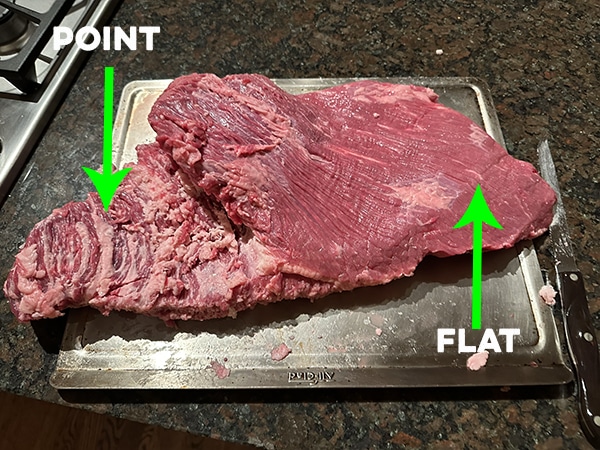
Flipped over
This bad boy has two parts: the flat and the point (sometimes called the deckle).
The flat is where you get those classic brisket slices from. It’s the side of the brisket that’s not covered in fat, so it’s a leaner portion of meat. The point is what yields your chopped brisket. It’s the fattier part of your brisket. You can also get what Karl calls “meat candy” from the point: burnt ends. More on that later.
A full packer brisket will weigh about 12-16 pounds.
The one I’m smoking in this article weighed 15 pounds.
You’re going to trim some of the fat off your brisket. Karl told me that you’ll probably cut off two to three pounds of fat. That took my brisket down to about 13 pounds.
“You’re going to get about 50-60% yield from an uncooked and untrimmed brisket,” Karl told me. “So take that into consideration when calculating how much meat you’ll have for each of your guests.” A good rule of thumb is to plan for each guest to eat about ½ pound of meat (they’ll probably eat more like 1/4 to 1/3 pounds, but it’s better to err on the side of having too much meat than too little). So a 13-pound brisket, once cooked, would yield about 7 pounds of meat and feed about 14 people.
Timing Your Brisket
The biggest issue first-time brisket smokers are going to have is timing.
Timing is a booger.
The last thing you want is for your guests to be waiting around for an hour because you put your brisket in the smoker too late.
Assuming a 250-degree Fahrenheit smoking temperature, you’ll want to cook your brisket for about 30-60 minutes per pound of meat.
This is a rough estimate. Cooking time will vary from brisket to brisket. Karl told me that he’s smoked briskets that weighed the same and one cooked pretty fast and one cooked slower even though he used the same temp on both. It’s going to depend on the meat and your smoker and the environmental conditions. Instead of focusing on time to gauge a brisket’s doneness, you have to focus on the internal temp of the meat.
It’s much better to allot too much cooking time than too little; one of your saving graces in timing a brisket is that you can let it rest wrapped up in a towel and in a cooler for up to 4 to 5 hours and your brisket will still be hot.
So if your brisket is done later than expected, that’s a problem (you’ve got hungry guests on your hands.) But if it’s done earlier than expected, it’s no worry.
So you’ll want to put your brisket in the smoker at a time that will allow for the max cook time (an hour per pound) and still have it ready at the scheduled dinner time. So a 15-pound brisket that weighs 13 pounds after the fat’s been trimmed off would need about 13 hours of cooking time. To that cook time, you then add a minimum of two hours you’re going to let the brisket rest after you take it off the smoker.
In our example of the 13-pound brisket, that means if you’re aiming for a 6 PM dinner time, you’d need to put the brisket in the smoker at around 3 AM (13 hours cook time + 2 hours rest time). Yes, you’ll need to sacrifice some shuteye for pitmaster glory. But trust me, it will be worth it.
Timing your brisket bottom line: Take your dinner time and subtract an hour per pound of meat + two hours for rest time. That’s about when you’ll want to put your brisket in the smoker.
Allow Your Brisket to Temper
About an hour to an hour and a half before you put your brisket in the smoker, pull it out of the fridge to let it temper. That’s just a fancy way to say, “Let the meat warm up to room temperature.” This will help you have juicier and evenly cooked meat.
Set Your Smoker to 250 Degrees Fahrenheit

For this brisket, I used hickory wood pellets. I loaded the hopper all the way to the top since the brisket was going to be in there for a long time. Make sure to check on your pellet supply in the hopper. You don’t want your smoker to go out.

When I asked Karl about the ideal temperature to smoke a brisket, he told me he’s tried cooking it low and slow at 225 degrees and hot and fast at 300 degrees. “Both can get you a good-tasting brisket, but over the years I’ve settled on 250 degrees,” he told me.
250 degrees it is then. Set your smoker to that temp and let it warm up.
Trim the Fat
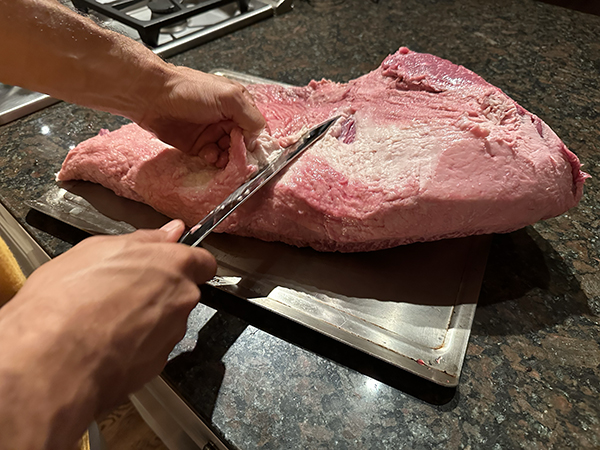
Now, when you get your brisket, you’re going to see a lot of fat on it. We’re trimming most of that off.
I know, I know, some of you are thinking, “But you’re cutting off all the flavor!”
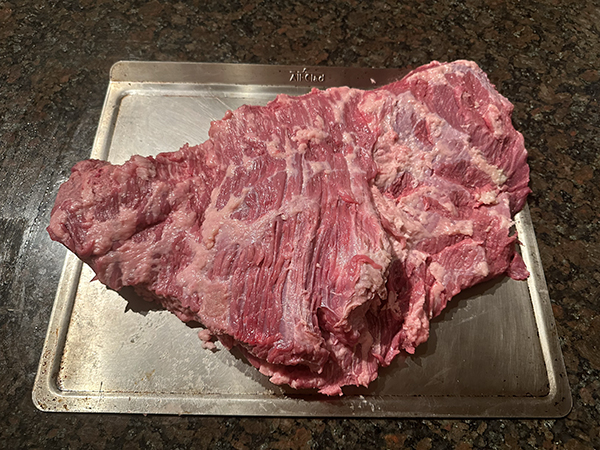
Karl likes to smoke lean brisket. He doesn’t trim all the fat off. He likes to leave about a quarter inch of fat. That’s plenty for flavor. And it’ll save you from putting all your delicious rub on something your guests aren’t going to eat anyway.
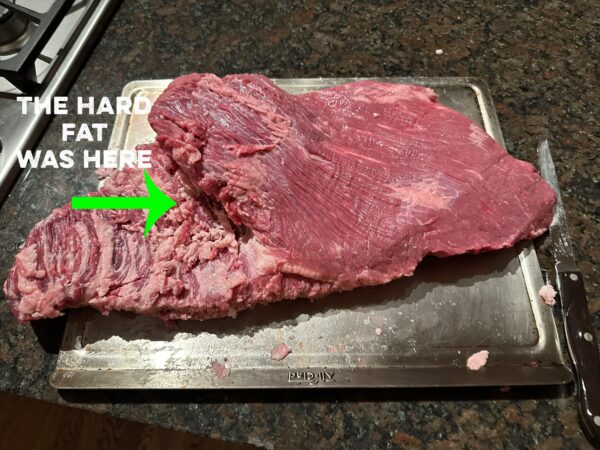
Make sure you get all the hard-feeling fat out of there. Most of it will be in the spot where the point and the flat connect. That stuff doesn’t render and is gross.
Prepping the Brisket
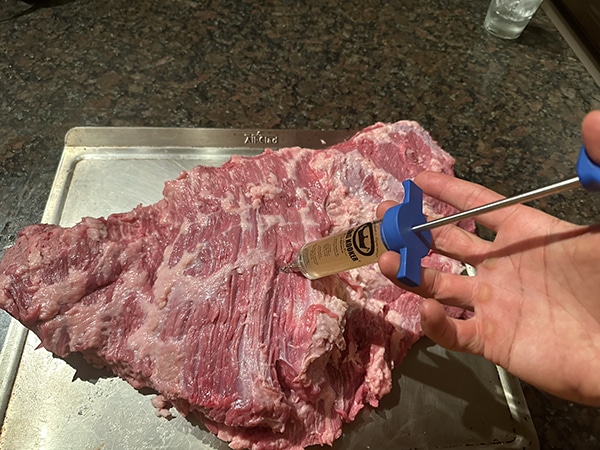
To help your brisket stay nice and juicy and for extra flavor, Karl recommends injecting the meat with a mixture of 70% beef broth and 30% water (Karl says using just straight broth imparts a flavor that’s too intense). Inject the solution in a grid pattern, about 1-2 inches apart, covering the meat from end to end.
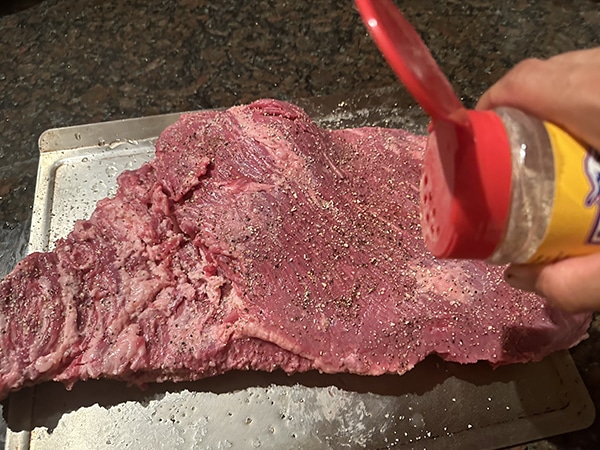
Now it’s time to season your brisket. There are a million ways to do so. Some folks keep it simple with salt, pepper, and a little garlic. Others go all out with a fancy rub.
I kept it simple and just used a salt, pepper, and garlic rub. Be generous! You’ve got a lot of meat to cover.
The Great Debate: Fat Side Up or Down?
Alrighty, your brisket is prepped and your smoker is at 250. It’s time to get your brisket cookin’.
Here’s where things get controversial. Fat side up or fat side down?
Karl’s done it both ways and gotten great results. It really depends on your cooker. If you’re using something like a rotisserie, go fat side up. If you’ve got the heat source directly underneath, you might want to go fat side down to protect the meat.
I went fat side down for my brisket.
The Cooking Process
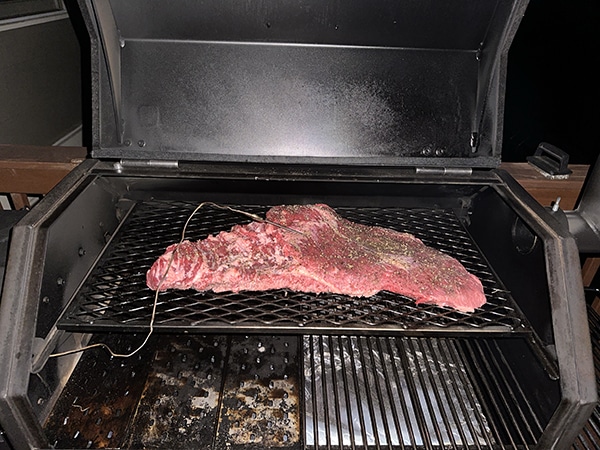
Put your brisket into the smoker. If it has internal temperature probes, put those in so you can monitor the temp of your brisket from your phone.
After about 4-5 hours, come back and spritz it with some 70/30 beef broth/water. Just keeps things moist.

When the brisket hits an internal temp of 165, “the stall” occurs. This is when the internal temp on your meat will hang out at around 165 to 175 for hours. You’ll reach the stall after about 7-8 hours of smoking.
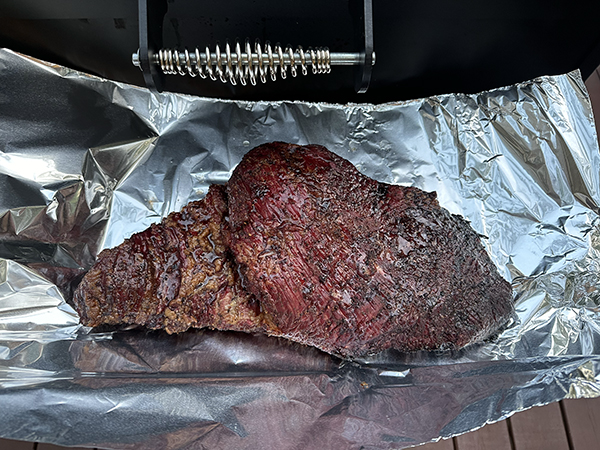
To overcome the stall and speed up the cooking process, we’re going to pull the brisket out of the smoker and double-wrap it in foil before returning it to the smoker.
Some folks call this the Texas Crutch. Karl just calls it “making sure your brisket is tender and flavorful and is ready to eat on time.”
Instead of foil, you can use butcher paper to wrap your brisket. Karl’s tried both over the years and says there’s not much difference.
One thing Karl did note was that you want to make sure your brisket has the color and bark you want on the outside before you wrap it because once you wrap it, the meat will no longer get any smoke.

After you’ve wrapped it in foil and put it back into the smoker, you’re going to leave it in there until the meat hits an internal temperature of 190-200 degrees. This could take one to two hours.
Let the Brisket Rest

After your brisket has reached an internal temperature of 190 degrees, pull it out of the smoker and wrap your foil-wrapped brisket in a beach towel (use one you don’t mind getting meat juice on).

You’re then going to place your foil+towel-wrapped brisket into a cooler and let it rest for at least two hours.
This step is crucial. It lets all those juices redistribute and everything just kind of calm down.
DO NOT OPEN THE COOLER DURING THE RESTING TIME! You’ll let out the heat.
Again, what’s nice about wrapping your brisket up in a towel and letting it rest inside of a cooler is that it can give you some leeway with your timing if your brisket gets done way ahead of schedule. This brisket got done earlier than expected, but I was able to let it rest inside the cooler for four hours. When I pulled it out at dinner time, it was still hot.
Chop the Point
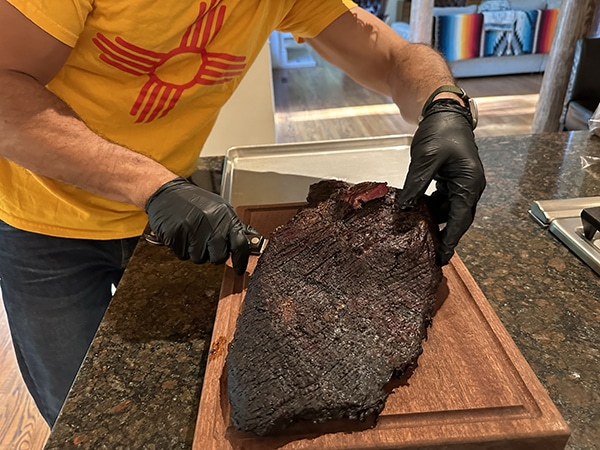
After your brisket has rested for two hours, pull it out of the cooler and unwrap it.
Man, that looks beautiful.

Separate the flat and the point. Put your flat to the side.
The point is my favorite part of the brisket. It’s nice and fatty.

We’re going to do a rough chop on this. We’ll use this part of the meat to make chopped brisket.
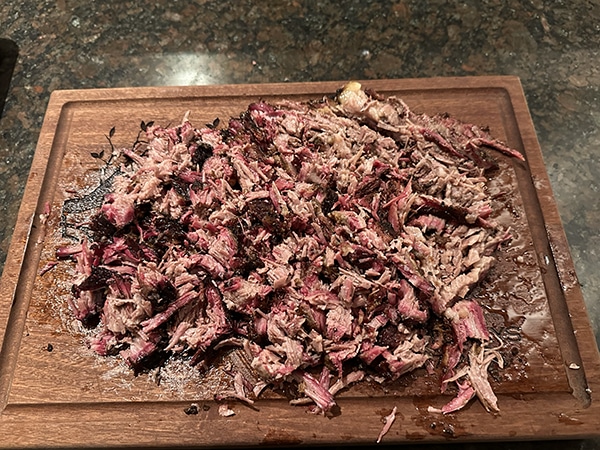
You can also make burnt ends out of the point. Just cube the meat, roll it around in some of the brisket’s juices, and then put it back into the smoker for about 40 minutes. Comes out incredibly tasty.
Slice the Flat
Now get your flat. We’re going to slice this up.
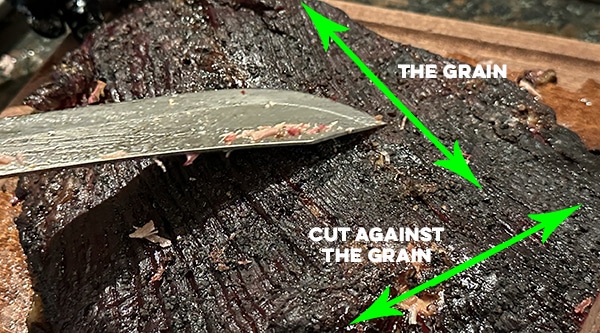
Here’s where a lot of people go wrong: When you’re slicing your brisket, you have to cut against the grain. This is gonna give you the most tender bite possible. I like to create slices about the thickness of a pencil.
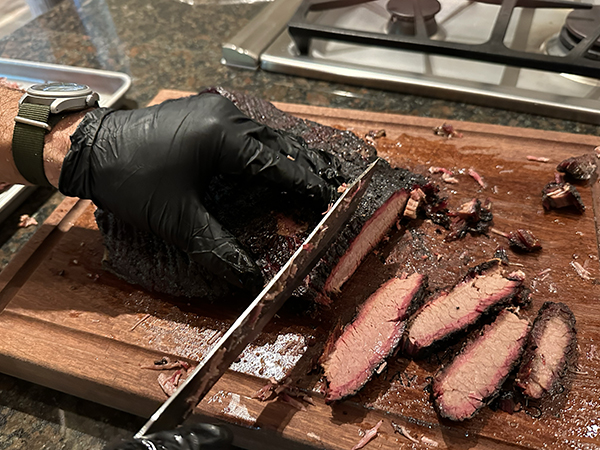
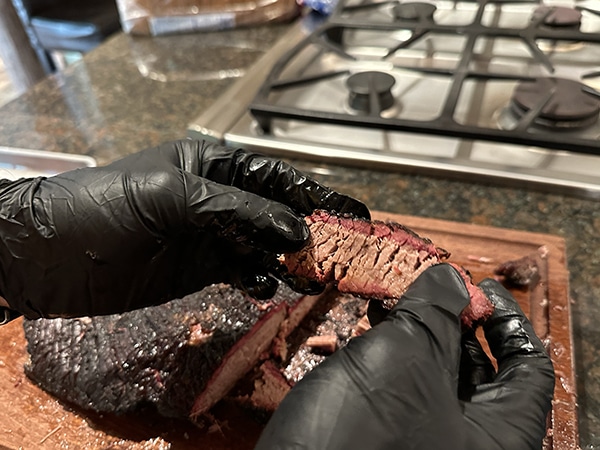
Check that smoke ring out.
There you have it, folks. The secrets to cooking your first, perfect brisket this weekend.
It takes time, it takes patience, but man, when you get it right, there’s nothing better. Your guests will sing your praises, and you’re gonna be the king of the block.


